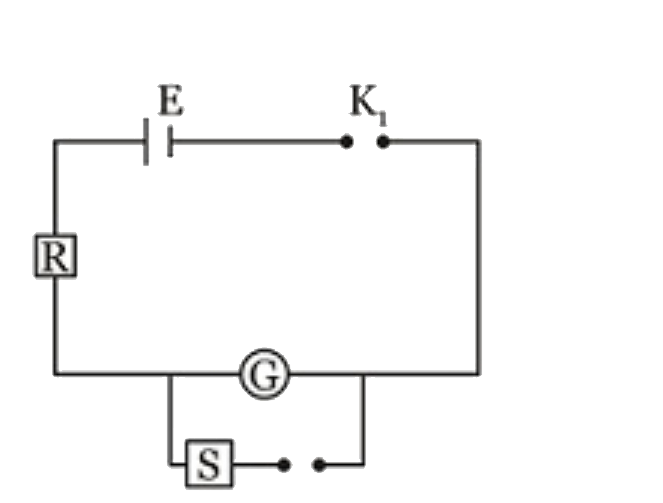In Kelvin's method of finding the resistance of a galvanometer, we
Circuit : The metre bridge circuit for Kelvin's method of determination of the resistance of a galvanometer is shown in the figure. The galvanometer whose resistance G is be determined, is connected in one gap of the metre bridge. A variable known resistance R is connected in the other gap. The junction B of the galvanometer and the resistance box is connected directly to a pencil jockey. A cell of emf E, a key (K) and a rheostat (Rh) are connected across AC.

Working : Keeping a suitable resistance R in the resistance box and maximum resistance in the rheostat, key K is closed to pass the current. The rheostat resistance is slowly reduced such that the galvanometer shows about 2/3 rd of the full-scale deflection.
On tapping the jockey at end-points A and C, the galvanometer deflection should change to opposite sides of the initial deflection. Only then will there be a point D on the wire which is equipotential with point B. The jockey is tapped along the wire to locate the equipotential point D when the galvanometer shows no change in deflection. Here, point D is called the balance point and Kelvin's method is thus an equal deflection method. At this balanced condition,
GR=resistance of the wire of length LGresistance of the wire of length LR
where LG≡ the length of the wire opposite to the galvanometer and LR≡ the length of the wire opposite to the resistance box.
If λ≡ the resistance per unit length of the wire,
GR=λLGλLR=LGLR ∴G=RLGLR
The quantities on the right hand side are known, so that G can be calculated.
Topper's Solved these Questions
- EXPERIMENTS AND DIAGRAMSBook:NAVNEET PUBLICATION - MAHARASHTRA BOARDChapter:EXPERIMENTS AND DIAGRAMSExercise:ELECTRONS AND PHOTONS
Explore 1 Video
- EXPERIMENTS AND DIAGRAMSBook:NAVNEET PUBLICATION - MAHARASHTRA BOARDChapter:EXPERIMENTS AND DIAGRAMSExercise:ATOMS, MOLECULES AND NUCLEI
Explore 1 Video
- EXPERIMENTS AND DIAGRAMSBook:NAVNEET PUBLICATION - MAHARASHTRA BOARDChapter:EXPERIMENTS AND DIAGRAMSExercise:CURRENT ELECTRICITY
Explore 1 Video
- DISTINGUISH BETWEENBook:NAVNEET PUBLICATION - MAHARASHTRA BOARDChapter:DISTINGUISH BETWEENExercise:Assingment
Explore 3 Videos
- EXPLANATION, CHARACTERISTICS AND PROPERTIES Book:NAVNEET PUBLICATION - MAHARASHTRA BOARDChapter:EXPLANATION, CHARACTERISTICS AND PROPERTIES Exercise:Assignments
Explore 2 Videos
Similar Questions
Knowledge Check
Kelvin's method of determination of resistance of galvanometer by metre bridge is
Aequal deflection methodBnull deflection methodCequal distance methodDall of theseIn a circuit for finding the resistance of a galvanometer by half deflection method, a 6 V battery and a high resistance of 11 kΩ are used. The figure of merit of the galvanometer is 60 μA/division. In the absence of shunt resistance, the galvanometer produces a deflection of θ=9 divisions when current flows in the circuit. The value of the shunt resistance that can cause the deflection of θ/2, is closet to :
A550ΩB220ΩC55ΩD110ΩIn an experiment to determine the resistance of a galvanometer by half deflection method, the circuit shown is used. In one set of readings , if R=10ΩS=4Ω, then the resistance of the galvanometer is
 A203ΩB403ΩC503ΩD703Ω
A203ΩB403ΩC503ΩD703Ω
If a galvanometer is connected in series with a high resistance so that potential drop across the galvanometer is 1/n th of the total applied voltage, then show that the combined resistance of the galvanometer and the series resistor is n times the resistance of the galvanometer i.e.,
View SolutionState the principle of working of a galvanometer.
A galvanometer of resistance G is converted into a voltmeter to measure upto V volts by connecting resistance R1 in series with the coil. If a resistance R2 is connected in series with it, then it can measure V/2 volts. Find the resistance, in terms of R1 and R2, required to be connected to convert it into a volt meter that can read upto 2 V. Also find the resistance G of the galvanometer in terms of R1 and R2.
View SolutionWhen a moving coil galvanometer is shunted with a resistance of 10Ω,the deflection in the galvanometer reduces from 30 divisions to 6 divisions. The resistance of the galvanometer is
View SolutionIn an ammeter 5% of the main current is passing through the galvanometer. If the resistance of galvanometer is G, then the resistance of shunt S will be
View SolutionW
View Solution

